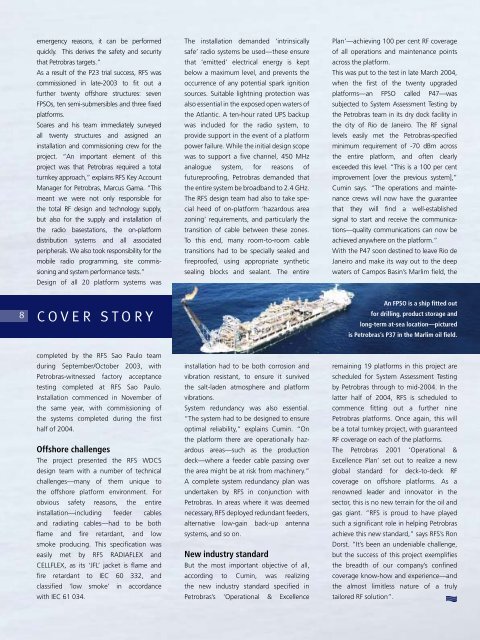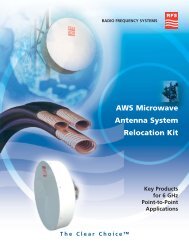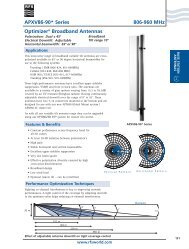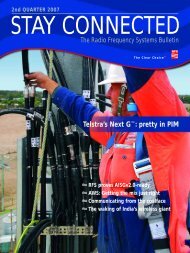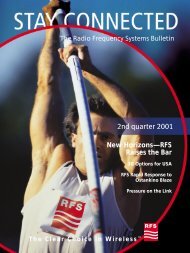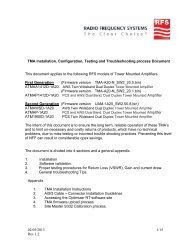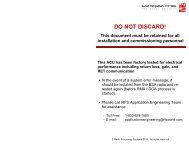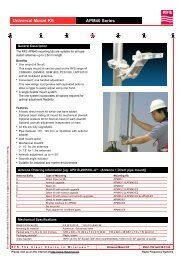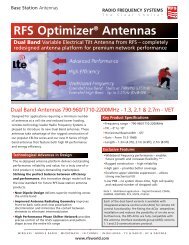download - Radio Frequency Systems
download - Radio Frequency Systems
download - Radio Frequency Systems
Create successful ePaper yourself
Turn your PDF publications into a flip-book with our unique Google optimized e-Paper software.
emergency reasons, it can be performed<br />
quickly. This derives the safety and security<br />
that Petrobras targets.”<br />
As a result of the P23 trial success, RFS was<br />
commissioned in late-2003 to fit out a<br />
further twenty offshore structures: seven<br />
FPSOs, ten semi-submersibles and three fixed<br />
platforms.<br />
Soares and his team immediately surveyed<br />
all twenty structures and assigned an<br />
installation and commissioning crew for the<br />
project. “An important element of this<br />
project was that Petrobras required a total<br />
turnkey approach,” explains RFS Key Account<br />
Manager for Petrobras, Marcus Gama. “This<br />
meant we were not only responsible for<br />
the total RF design and technology supply,<br />
but also for the supply and installation of<br />
the radio basestations, the on-platform<br />
distribution systems and all associated<br />
peripherals. We also took responsibility for the<br />
mobile radio programming, site commissioning<br />
and system performance tests.”<br />
Design of all 20 platform systems was<br />
The installation demanded ‘intrinsically<br />
safe’ radio systems be used—these ensure<br />
that ‘emitted’ electrical energy is kept<br />
below a maximum level, and prevents the<br />
occurrence of any potential spark ignition<br />
sources. Suitable lightning protection was<br />
also essential in the exposed open waters of<br />
the Atlantic. A ten-hour rated UPS backup<br />
was included for the radio system, to<br />
provide support in the event of a platform<br />
power failure. While the initial design scope<br />
was to support a five channel, 450 MHz<br />
analogue system, for reasons of<br />
futureproofing, Petrobras demanded that<br />
the entire system be broadband to 2.4 GHz.<br />
The RFS design team had also to take special<br />
heed of on-platform ‘hazardous area<br />
zoning’ requirements, and particularly the<br />
transition of cable between these zones.<br />
To this end, many room-to-room cable<br />
transitions had to be specially sealed and<br />
fireproofed, using appropriate synthetic<br />
sealing blocks and sealant. The entire<br />
Plan’—achieving 100 per cent RF coverage<br />
of all operations and maintenance points<br />
across the platform.<br />
This was put to the test in late March 2004,<br />
when the first of the twenty upgraded<br />
platforms—an FPSO called P47—was<br />
subjected to System Assessment Testing by<br />
the Petrobras team in its dry dock facility in<br />
the city of Rio de Janeiro. The RF signal<br />
levels easily met the Petrobras-specified<br />
minimum requirement of -70 dBm across<br />
the entire platform, and often clearly<br />
exceeded this level. “This is a 100 per cent<br />
improvement [over the previous system],”<br />
Cumin says. “The operations and maintenance<br />
crews will now have the guarantee<br />
that they will find a well-established<br />
signal to start and receive the communications—quality<br />
communications can now be<br />
achieved anywhere on the platform.”<br />
With the P47 soon destined to leave Rio de<br />
Janeiro and make its way out to the deep<br />
waters of Campos Basin’s Marlim field, the<br />
8 C OVER STORY<br />
An FPSO is a ship fitted out<br />
for drilling, product storage and<br />
long-term at-sea location—pictured<br />
is Petrobras’s P37 in the Marlim oil field.<br />
completed by the RFS Sao Paulo team<br />
during September/October 2003, with<br />
Petrobras-witnessed factory acceptance<br />
testing completed at RFS Sao Paulo.<br />
Installation commenced in November of<br />
the same year, with commissioning of<br />
the systems completed during the first<br />
half of 2004.<br />
Offshore challenges<br />
The project presented the RFS WDCS<br />
design team with a number of technical<br />
challenges—many of them unique to<br />
the offshore platform environment. For<br />
obvious safety reasons, the entire<br />
installation—including feeder cables<br />
and radiating cables—had to be both<br />
flame and fire retardant, and low<br />
smoke producing. This specification was<br />
easily met by RFS RADIAFLEX and<br />
CELLFLEX, as its ‘JFL’ jacket is flame and<br />
fire retardant to IEC 60 332, and<br />
classified ‘low smoke’ in accordance<br />
with IEC 61 034.<br />
installation had to be both corrosion and<br />
vibration resistant, to ensure it survived<br />
the salt-laden atmosphere and platform<br />
vibrations.<br />
System redundancy was also essential.<br />
“The system had to be designed to ensure<br />
optimal reliability,” explains Cumin. “On<br />
the platform there are operationally hazardous<br />
areas—such as the production<br />
deck—where a feeder cable passing over<br />
the area might be at risk from machinery.”<br />
A complete system redundancy plan was<br />
undertaken by RFS in conjunction with<br />
Petrobras. In areas where it was deemed<br />
necessary, RFS deployed redundant feeders,<br />
alternative low-gain back-up antenna<br />
systems, and so on.<br />
New industry standard<br />
But the most important objective of all,<br />
according to Cumin, was realizing<br />
the new industry standard specified in<br />
Petrobras’s ‘Operational & Excellence<br />
remaining 19 platforms in this project are<br />
scheduled for System Assessment Testing<br />
by Petrobras through to mid-2004. In the<br />
latter half of 2004, RFS is scheduled to<br />
commence fitting out a further nine<br />
Petrobras platforms. Once again, this will<br />
be a total turnkey project, with guaranteed<br />
RF coverage on each of the platforms.<br />
The Petrobras 2001 ‘Operational &<br />
Excellence Plan’ set out to realize a new<br />
global standard for deck-to-deck RF<br />
coverage on offshore platforms. As a<br />
renowned leader and innovator in the<br />
sector, this is no new terrain for the oil and<br />
gas giant. “RFS is proud to have played<br />
such a significant role in helping Petrobras<br />
achieve this new standard,” says RFS’s Ron<br />
Dorst. “It’s been an undeniable challenge,<br />
but the success of this project exemplifies<br />
the breadth of our company’s confined<br />
coverage know-how and experience—and<br />
the almost limitless nature of a truly<br />
tailored RF solution”.


